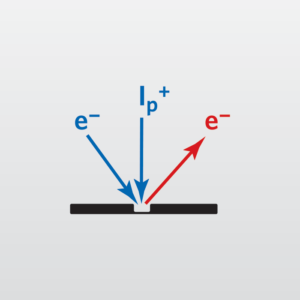Plasma FIB (P-FIB)
Home » Our Techniques » Imaging » Plasma FIB
Plasma FIB (P-FIB) extends conventional DualBeam (DB) capabilities to nearly mm scale without the use of Gallium. DualBeam is the industry standard technique for highly localized materials characterization and failure analysis. DBs typically use a Ga FIB to modify the sample while monitoring those changes using a Scanning Electron Microscope (SEM) in-situ. P-FIB refers to the same DB instrument, but the liquid metal Ga ion source is replaced with a plasma ion source. Typically, Xe gas is used to form the plasma ion source. By employing Xe instead of Ga, the maximum usable beam current of the instrument increases ~40X, enabling efficient milling of structures approaching 1mm in dimension. The ability to inspect much larger volumes of material extends characterization and failure analysis capabilities to samples that previously required mechanical grinding and polishing to prepare as well as fragile samples. Cross-sectioning of entire ball bonds or die-to-die interconnects such as TSVs becomes routine, all without imparting additional mechanical stresses or polishing media inclusion into softer metal or polymer layers.

In addition to larger cross-sectioning capability, P-FIB can also perform identical sample preparation for SEM or (S)TEM, just replacing Ga with Xe. Using Xe can be highly beneficial for the elimination of certain Ga related artifacts. Since Ga alloys with most metals and is highly mobile on the surface of the sample during the milling process, it often diffuses into metal-semiconductor interfaces and grain boundaries causing complications for any follow-up analytical work, such as STEM-EDS/EELS. For certain techniques like EBIC or Cathodoluminescence, use of Xe mitigates growth of the conductive damage layer that occurs due to the physical sputtering process (amorphization and implantation), and greatly improves signal to noise of the subsequent analysis.
For certain samples the sputtering process can create significant amounts of heat which can change the inherent sample structure. To mitigate this issue, P-FIB can be performed on samples at low temperature using a cryo-stage. This reduces or even eliminates thermally aided diffusion and or melting of sensitive samples. enabling cross-sectioning of soft materials such as polymers and low melting point metals such as In ball bumps. In addition, the cryo-stage can be combined with a glovebox-compatible air-free transfer system to analyze battery materials that are rich in lithium.
Strengths
- Large Cross-sections up to ~1mm wide
- Ga free analysis – SEM or TEM sample preparation, SEM-EBIC, STEM-EBIC, SEM-CL
- Best method to cross-section larger targets
- Precision IC delayering possible over relatively large areas 200×200µm
- Rapid, high-resolution imaging
- Good grain contrast imaging
- Versatile platform that supports many other tools
Limitations
- Destructive technique
- Vacuum compatibility typically needed
- Imaging may spoil later analyses
- Ion beam damage may limit image resolution
- Cross-section area is limited to sub 1mm
- Targeting very small features for TEM more challenging than Ga DB
Plasma FIB Technical Specifications
- Signals Detected: Electrons, secondary ions, characteristic X-rays (equipped with EDS detector)
- Imaging/Mapping: Yes – 3D Volumes
- Lateral Resolution/Probe Size: 20 nm (ion beam); 0.7 nm (electron beam)
EAG has decades of experience in Dual Beam analysis and is one of the only commercial laboratories providing plasma FIB services in the United States. Our network of laboratories offer a wide range of materials’ expertise in fields ranging from semiconductors to displays to batteries.
We are able to optimize PFIB recipes for a diverse set of materials systems. Our PFIB also has several addon features such as an EDS detector (SEM-EDS apps note link), cryo stage (cryo stage link), and ThermoFisher delayering DX gas chemistry allowing for many different types of in situ analyses. In addition, EAG also has many complementary techniques to PFIB such as (S)TEM-EDS and EELS, EBIC, SCM, and more. This makes multi-technique analyses extremely streamlined and efficient.
Would you like to learn more about using Plasma FIB?
Contact us today for your Plasma FIB needs. Please complete the form below to have an EAG expert contact you.